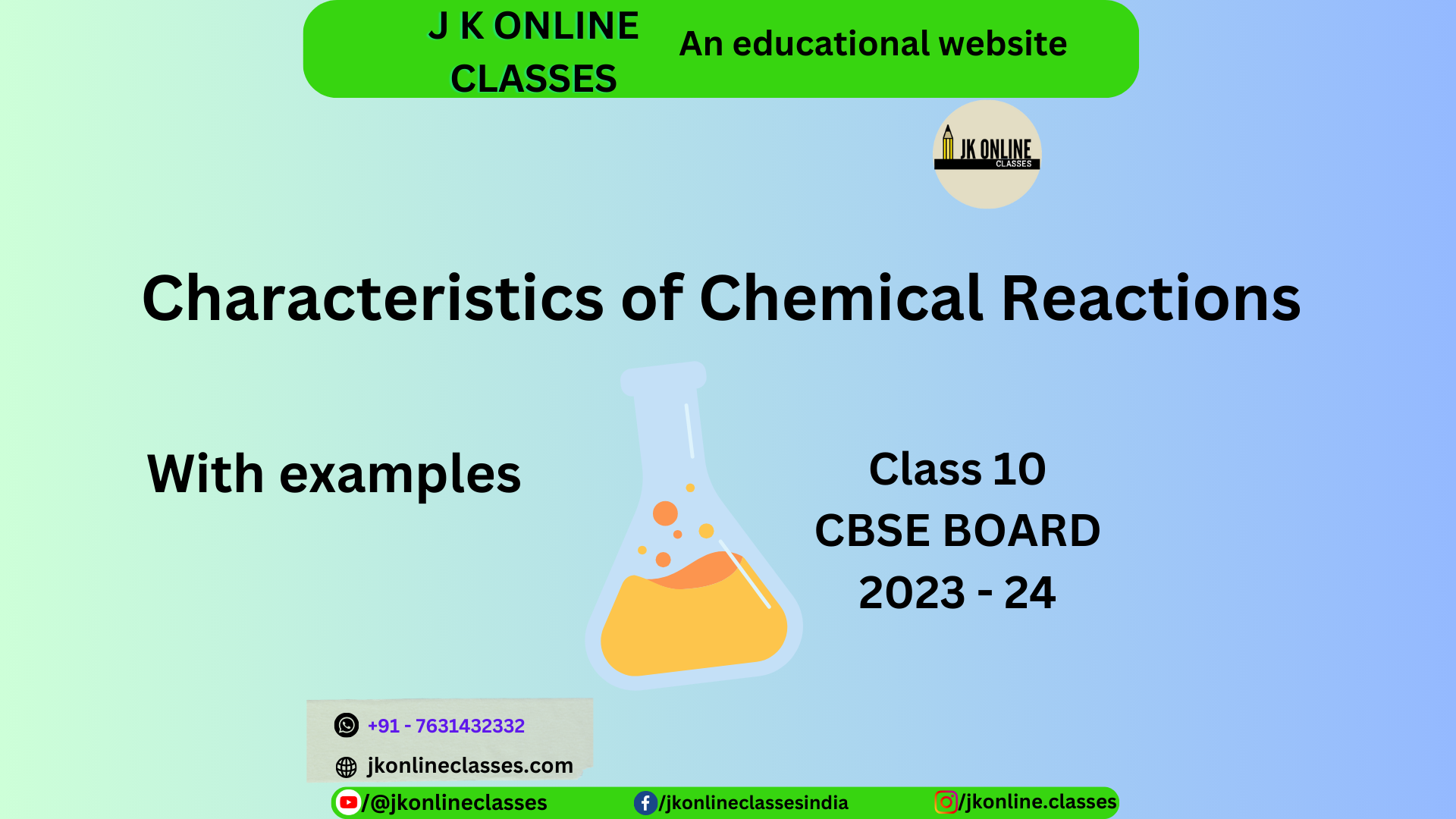In any chemical reaction, the substances known as reactants gets converted into new substances called products. The conversion of reactants into products in a chemical reaction is often accompanied by some features which can be easily observed. These observable features which took place as a result of chemical reactions are known as characteristics of chemical reactions. Few of important characteristics of chemical reactions are:

Characteristics of chemical reactions (J K Online Classes)
Characteristics of Chemical Reactions:
1. Formation of New Substances:
- Chemical reactions result in the creation of new substances with different properties than the original ones.
Example: When a magnesium (Mg) ribbon is burnt in air or in the presence of oxygen, it gets converted into Magnesium Oxide. The process involves the burning of ribbon with sparkling white flame, and the ribbon gets converted into ashes.
Chemical Equation Involved:
\[ 2Mg + O_2 \rightarrow 2MgO \]
2. Change in Temperature:
- Reactions involve the absorption or release of energy. Endothermic reactions absorb energy, while exothermic reactions release energy.
Some chemical reactions are characterized by change in temperature, like while chemical reaction takes place. There can be either absorption of heat or releasing of heat.
2.1 Endothermic reaction
The reaction between barium hydroxide (\(Ba(OH)_2\)) and ammonium chloride (\(NH_4Cl\)) is an endothermic property and the formation of precipitates and is also a double displacement reaction.
The balanced chemical equation for this reaction is:
\[ Ba(OH)_2 + 2NH_4Cl \rightarrow 2NH_4OH + BaCl_2 + 2H_2O \]
When performing this reaction in a laboratory setup, you might notice a decrease in temperature in the surrounding area of the reaction mixture. The vessel might feel cooler to the touch or a thermometer placed nearby could register a drop in temperature.
2.1 Exothermic reaction
When quick lime reacts with water, then slaked lime is formed and a lot of heat energy is produced. The heat raises the temperature due to which the reaction mixture becomes hot.
The reaction between quicklime (calcium oxide, CaO) and water (\(H_2O\)) is highly exothermic and results in the formation of slaked lime (calcium hydroxide, \(Ca(OH)_2\)). This reaction is known as slaking of lime and is utilized in various applications, including construction, agriculture, and chemical processes.
The balanced chemical equation for this reaction is:
\[ CaO + H_2O \rightarrow Ca(OH)_2 \]
When performing this reaction in a laboratory setup, you might notice a increase in temperature in the surrounding area of the reaction mixture. The vessel might feel warmer to the touch or a thermometer placed nearby could register a rise in temperature.
3. Change in Color:
- Some reactions cause a change in color as new substances are formed.
Some chemical reactions are characterised by change in colour. Few examples are as follows:
Table 1.3 Two examples of chemical equations showing change in colour
1. | 2. |
When Potassium Permanganate (KMnO4) reacts with Citric Acid (C6H8O7), the purple colour of Potassium Permanganate disappears. i.e., the reaction between Citric acid and Potassium Permanganate is characterised by change in colour from purple to colourless. | The orange colour of acidified Potassium Dichromate (K2Cr2O7) solution changes to green when Sulphur Dioxide (SO2) gas is passed through it. i.e., the reaction between sulphur dioxide gas and acidified potassium dichromate is characterised by change in colour from orange to green. |
4. Evolution of Gas:
- Gas may be produced during a reaction, leading to the formation of bubbles or effervescence.
There are some chemical reactions which involves the evolution of gases. Few examples are as follows:
Table 1.5 Two examples of chemical reactions showing evolution of gas
1. | 2. |
When zinc (Zn) reacts with dilute sulphuric acid (dil. H2SO4), evolution of hydrogen gas takes place. The same experiment can also be done by reacting zinc with the dilute hydrochloric acid. | When magnesium (Mg) reacts with dilute sulphuric acid (dil. H2SO4) or dilute hydrochloric acid, the also the evolution of hydrogen gas takes place. |
5. Change in State:
- The physical state of reactants and products may change (solid to liquid, liquid to gas, etc.).
Change in state means changing of form either from solid to liquid, liquid to gas, gas to liquid like this. Some chemical reactions involve change in physical states also. Few examples are as follows:
Table 1.4 Two examples of chemical equations showing change in state
1. | 2. |
Melting of ice in to water in one such example which involves the change of solid ice into the liquid water. |
Burning of wax candle leads to formation of liquid and carbon dioxide. |
6. Formation of precipitation:
- The physical state of reactants and products may change (solid to liquid, liquid to gas, etc.).
Precipitate is a solid insoluble compound which is formed when chemical reaction takes place. Few examples are as follows:
Table 1.6 Two examples of chemical reactions showing formation of precipitate
1. | 2. |
When potassium iodide (KI) solution reacts with solution of lead nitrate (Pb(NO3)2), a yellow precipitate of lead iodide is formed. Thus, reaction between potassium iodide and lead nitrate is characterised by formation of yellow precipitate of lead iodide. | The reaction between dilute sulphuric acid (dil. H2SO4) and barium chloride (BaCl2) lead to the formation of white precipitate of barium sulphate. This formation of white precipitate of barium sulphate shows the reaction between sulphuric acid and barium chloride. |









.png)

0 Comments